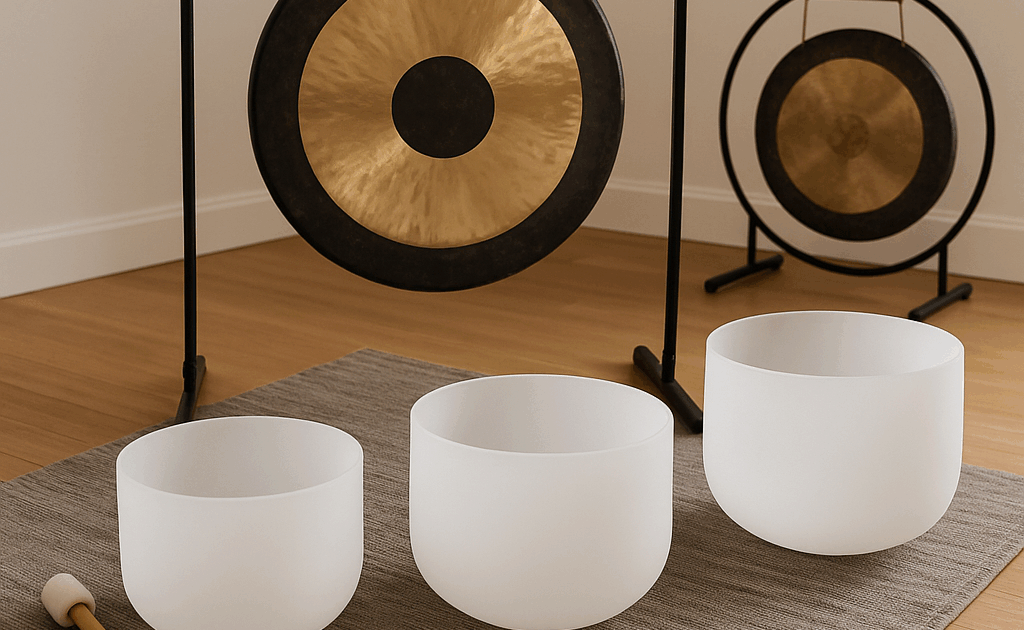Close your eyes for a moment and imagine being wrapped in waves of sound—deep, soothing tones that seem to flow not just around you, but through you. Your breath slows. Your shoulders soften. The steady hum feels almost like your nervous system is exhaling. This is the experience of a sound bath. And while it may feel mystical, the calming effect is deeply grounded in neuroscience! Sound vibrations directly interact with the brain, body, and nervous system, creating conditions for safety, rest, and healing.
What Is a Sound Bath?
A sound bath is an immersive experience where you are “bathed” in resonant tones—often produced by instruments like singing bowls, gongs, tuning forks, or chimes. Unlike music with lyrics or rhythm, these tones are typically long, sustained, and rich in vibration. Instead of telling a story to the mind, they create a sensory landscape for the body to rest and reorganize its patterned response.
How Does Sound Healing Work? The Science Behind It
Sound healing uses the body’s natural sensitivity to vibration to promote relaxation, clear blockages, and restore balance. Let’s break down how it works on multiple levels:
1) Resonance and Frequency Alignment
Every organ and system in the body vibrates at its own frequency. When exposed to external sounds—like the deep hum of a gong or the shimmering tones of a crystal bowl, your body “absorbs” those frequencies and begins to mirror them. Resonanceis the principle: just as one tuning fork can cause another to vibrate, sound can help the body reset into harmony. For instance, research shows that frequencies between 40–150 Hz stimulate the Vagus Nerve, a key regulator of stress, digestion, and emotional balance. By toning this nerve, sound can reduce anxiety and even strengthen immune functioning.
Sound Doesn’t Just Enter Your Ears… It Rewires Your Nervous System.
2) Brainwave Entrainment
Your brain operates through rhythmic electrical patterns known as brainwaves. Each wave frequency is linked to a different state of consciousness. Research shows that sound frequencies can entrain the brain, syncing its rhythms with external sound, making it easier to enter restorative states:
- Delta (0.5–4 Hz): Deep sleep; physical repair
- Theta (4–8 Hz): Dreamlike, meditative states; creativity and emotional processing
- Alpha (8–12 Hz): Relaxed alertness; reduced stress
- Beta (12–30 Hz): Active thinking and problem-solving; often overactive in anxiety
- Gamma (30+ Hz): Integration, insight, expanded states of awareness
This synchronization, sometimes called the frequency-following response, allows for profound shifts in mood, awareness, and even pain perception.
3) Biophysics of Sound at the Cellular Level
Our bodies are about 60% water, making them excellent conductors of vibration. Through a phenomenon called cymatics, sound waves create orderly patterns in water. Inside us, this may:
-
-
- Tune cells back into harmony, supporting rejuvenation and reduce cellular stress
- Stimulate biological repair processes, improve circulation, and enhance energy flow
- Shift water molecule structures, improving hydration and waste removal
-
Some researchers suggest even the tiny antenna-like structures on cells (primary cilia) respond to sound, influencing how cells function and communicate. with one another.
4) Effects on the Nervous System and Hormones
Sound healing doesn’t just relax the mind—it directly engages the body’s regulation systems:
- Activates the parasympathetic nervous system; encouraging rest and repair
- Reduces cortisol; the main stress hormone
- Boosts serotonin, dopamine, and endorphins; enhancing well-being and connection
Sound offers a non-invasive, drug-free way to activate the body’s intrinsic calming systems. For instance, low-frequency vibrations are especially effective at increasing vagal tone—a marker of resilience and emotional regulation. Higher vagal tone is linked to better digestion, lower inflammation, and greater capacity for calm. This is why listeners often emerge from sound baths not just relaxed, but lighter, clearer, and more balanced.

5) Beyond Relaxation: The Physical Health Impact
Sound baths don’t just “feel good.” Studies show measurable improvements across several health markers:
- Heart Rate Variability: Increases, signaling parasympathetic dominance
- Cortisol: Levels drop, easing stress
- Blood Pressure: Reductions recorded in multiple studies
- Pain Management: People with fibromyalgia, arthritis, and post-surgical pain have reported reduced pain and improved mobility after repeated sound sessions
Neurologist Dr. Kulreet Chaudhary explains that because our cells live in a water-rich environment, sound waves can directly influence their function, helping reduce pain, ease inflammation, and support long-term healing.
6) Induced Mind Expansion and Flow
Many participants describe sound baths as timeless, dreamlike, or even cathartic. These experiences are signs of expanded states of consciousness, similar to deep meditation or creative “flow.”
Brain scans suggest that during these states, the default mode network—the brain system tied to self-talk and rumination—quiets down. This opens space for emotional integration, presence, and new perspectives.
What Frequencies Are Actually Used?
Despite claims of “perfect healing frequencies,” most sound bath instruments produce complex layers of sound:
- Tibetan singing bowls: 110–660 Hz, often aligning with alpha/theta ranges
- Crystal singing bowls: 400–800 Hz, sustained tones linked to vibrational alignment
- Gongs: Deep bass (50 Hz) to highs above 1,000 Hz, creating an immersive soundscape
It’s these rich harmonic layers—not isolated tones—that make sound baths so profoundly effective.
What a Sound Bath Session Feels Like
Imagine lying in a dim, cozy room. Your eyes are closed. Around you, tones rise and fall—some grounding, some shimmering. The sounds don’t demand attention; they simply wash through you.
You may notice your body settling. Breath deepening. For some, emotions surface and release. For others, the state feels like floating or dreaming. Each session is unique—but nearly always deeply restful.
Why Bottom-Up Therapies Such as Sound Bath Work When Talking Doesn’t?
Sometimes, the deepest wounds don’t have words. For many of our clients, especially those living with trauma, talking about the problem can bring more activation, not less. Sound baths, like other bottom-up therapies, begin with sensation, rhythm, and the body. They don’t require analysis or storytelling. They meet the nervous system where it is and offer safety first. From there, healing becomes possible.
How Sound Baths Complement Psychotherapy
Think of a sound bath as a bridge. It helps prepare the nervous system for deeper therapeutic work by first creating safety and calm.
When paired with psychotherapy—especially modalities like EMDR, breathwork, integration therapy, or somatic practices—sound baths help our clients engage in sessions more openly, regulated, and ready for growth.
Think of It as Tuning Your Nervous System, One Frequency at a Time.
Who Is Sound Bath Helpful For?
Sound bath therapy can benefit anyone, but is especially supportive for those who:
- Feel overwhelmed or stuck in thought loops
- Struggle with anxiety, PTSD, or chronic stress
- Find traditional mindfulness difficult
- Feel disconnected from their bodies
- Long for rest but struggle to access it
When You’re Ready, We’re Here!
At Inner Summits, we believe healing happens when body, mind, and nervous system align. If you’re curious about how sound therapy or other bottom-up approaches can support your journey, we’re here to guide you… gently and with care.
Get Matched with a Therapist.
Because finding support should never be as hard as what you’re going through.
